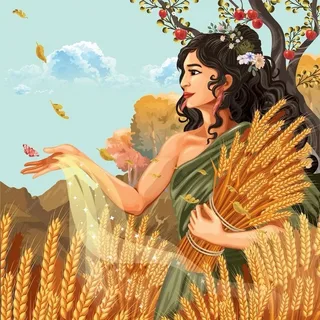Wheat is more than just a crop—it’s a symbol of life, sustenance, and human ingenuity. If we were to personify wheat, to imagine it as a living entity with a voice and a story to tell, what would it say? What kind of character would it embody? In this blog post, we’ll explore the personification of wheat, imagining it as a timeless figure that has witnessed the rise and fall of civilizations, nurtured countless generations, and shaped the course of human history.

Meet Demeter’s Child: The Spirit of Wheat
In ancient Greek mythology, Demeter, the goddess of agriculture, was often associated with wheat and the harvest. If wheat were personified, it might be seen as one of Demeter’s children—a gentle yet powerful spirit, embodying both the fragility and resilience of life. Let’s call this spirit Triticum, named after wheat’s scientific genus, Triticum aestivum.
Triticum would be a figure of quiet strength, with golden hair that ripples like fields of grain in the wind. Their eyes would hold the wisdom of millennia, reflecting the countless hands that have sown, harvested, and cherished wheat over the ages. Triticum’s voice would be soft but firm, carrying the weight of history and the promise of nourishment.
The Journey of Triticum: A Witness to Human History
If Triticum could speak, they would tell stories of their birth in the Fertile Crescent, where early farmers first cultivated their wild ancestors. They would recount their journey across continents, carried by nomadic tribes, traders, and explorers. Triticum would speak of the ancient Egyptians, who baked bread in their honor, and the Romans, who built empires fueled by wheat.
Triticum would also share tales of their arrival in Georgia, where they found a home in the fertile valleys of the Caucasus. They would describe the warmth of the Georgian sun, the sound of farmers singing as they harvested the fields, and the joy of being transformed into shotis puri, the iconic bread baked in traditional tone ovens.
The Dual Nature of Triticum: Nurturer and Teacher
As a personified being, Triticum would embody both nurturing and teaching. They would be a provider, offering their grains to feed the hungry and sustain communities. But they would also be a teacher, imparting lessons about patience, resilience, and the cycles of life.
Triticum would remind us of the importance of respecting the land, of working in harmony with nature rather than exploiting it. They would speak of the challenges they’ve faced—droughts, pests, and the encroachment of modern industrialization—and urge us to find sustainable ways to cultivate and protect the earth.
Triticum’s Message to the Modern World
In today’s fast-paced, technology-driven world, Triticum’s message would be one of balance and mindfulness. They would encourage us to reconnect with the roots of our food, to appreciate the labor and love that goes into every loaf of bread, and to honor the traditions that have kept wheat alive for thousands of years.
Triticum would also challenge us to address the pressing issues facing agriculture today, from climate change to food insecurity. They would inspire us to innovate, to find ways to grow wheat that are both productive and sustainable, ensuring that future generations can continue to benefit from this ancient gift.
The Personification of Wheat: A Living Legacy
Personifying wheat as Triticum allows us to see this humble grain in a new light—not just as a crop, but as a living, breathing entity with a rich history and a vital role in our lives. Triticum’s story is our story, a testament to the enduring bond between humans and the earth.
So, the next time you hold a piece of bread or gaze out at a field of golden wheat, take a moment to think of Triticum. Imagine their gentle presence, their timeless wisdom, and their unwavering commitment to nourishing the world. In doing so, you’ll be honoring not just wheat, but the countless generations of farmers, bakers, and dreamers who have made its journey possible.



